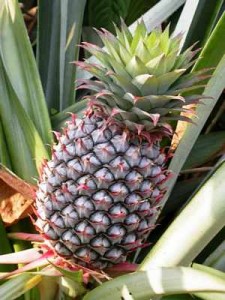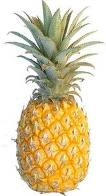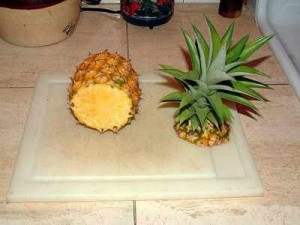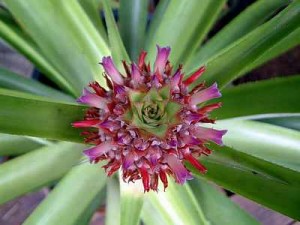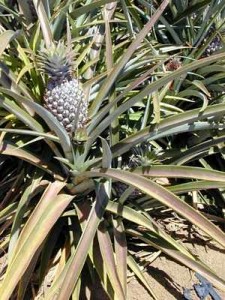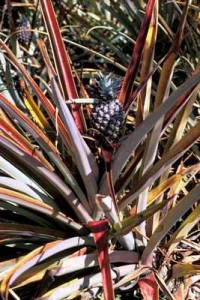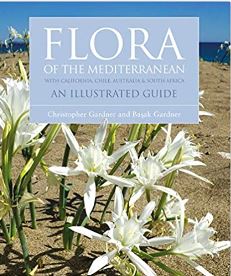Try Pineapples growing in your Garden in Spain
PINEAPPLES How to grow your own new pineapple from the left behind top of your now eaten pineapple All varieties can be propagated in the same way Selection of Spanish Gardening guides for you.
The Pineapple are exotic tropical fruits
Pineapples are one of the world’s most unique and exotic tropical fruits.
The pineapple (Ananas comosus) is one of the few edible species of the 2,000 that make up the bromeliad family and is the only bromeliad fruit in widespread cultivation.
Not only are pineapples delicious, but they are also very easy to grow.
Ananas comosus
bromeliad
History & plant info:
Pineapples are native to the southern part of Brazil and Paraguay wherefrom they spread throughout South America and eventually reached the Caribbean.
When explorer Christopher Columbus observed them growing in the Caribbean in 1493, they were being grown outside people’s homes as a sign of welcome.
Pineapples and Columbus
Columbus brought the pineapple back with him to Europe and the tradition was picked up by European cultures.
In mid 17th century Europe carved stone pineapples were often placed on entrances to houses.
This herbaceous perennial plant grows to 1-1.5m tall, and up to the same across, with 30 or more pointed leaves surrounding a thick stem.
They are prickly plants so leave space for ease of access.
The pineapple is an example of a multiple fruit:
Multiple, spirally-arranged flowers along the axis each produce a fleshy fruit that becomes pressed against the fruits of adjacent flowers, forming what appears to be a single fleshy fruit.
Pineapples are best suited to humid coastal lowlands in tropical and subtropical regions, but in a warm, sunny, sheltered and frost free position, they will tolerate cool nights for short periods.
In our warm climate you can plant your pineapple directly into the ground.
If your winter weather is any worse than the occasional freeze, plant your pineapple in a pot where you can take it inside.
When planting pineapples in the ground, it is important to ensure they have free drainage. Wet roots are the enemy of pineapples.
herbaceous perennial plant
How to grow your own pineapples
How to grow your own pineapples:
Pineapples can be grown very easily from the top of a pineapple that have been bought and eaten.
All varieties can be propagated in the same way.
Although you may not be able to grow as large a plant as is grown on a plantation in Hawaii, the following information should permit you to grow a healthy, attractive pineapple for your home:
Pineapples Cut off the Crown
1. Get your favorite pineapple from the local market or supermarket. Cut off the crown from the top of the fruit and set aside. Eat the rest of the fruit as you normally would.
2 Allow the bottom of the crown to dry out for a day or two.
Three Plant in sandy well-drained soil in a sunny location.
4. Water weekly in the beginning. Pineapples, like most bromeliads, prefer water in their vase-like tops, but do not need much water when established. They can get by on very little.
Once the young plant is established, pour a cupful of well balanced diluted water soluble liquid fertilizer into the top of the plant monthly.
Pineapples take up a lot of their nutrition through their leaves, and the first few months after planting they rely only on their leaves.
5. Avoid getting dirt or sand into the buds at the top of the plant as it may kill it.
Pineapples Flowering & fruiting:
Growing pineapples from crowns can seem to take forever, but typically they produce fruit within eighteen months to two years.
A pineapple plant will flower as soon as it is big enough, so the happier it is, and the better you look after, it the sooner it will flower.
Once a pineapple flowers you have to wait for another 5 to 7 months for the fruit to mature.
The fruit is ready to pick when it starts to turn yellow. Green pineapples are immature and toxic.
It is only when they have developed the classic orange colour that they are ready to eat.
Flowering & fruiting pineapples
The fruit will start forming in the centre of the pineapple plan
Fruit will start forming in the centre of the pineapple plant. It starts out looking like a large bright red and yellow flower.
The flower eventually transforms into the normal looking pineapple fruit that everyone is familiar with.
Either during or after the fruit on the mother plant has ripened, one or more shoots will grow from the mother-plant stem.
If you want your original plant to produce another fruit, leave one or at most two of the shoots on the plant to produce a second fruit.
If the plant remains healthy, it may even be possible to produce a third crop.
Pineapples Cut off excess shoots
Excess shoots can be cut off and planted.
Prepare and grow your shoots in the same manner you did your crown. Because they are larger, shoots will produce a fruit in less time than it takes for a crown.
If you have enough space you can theoretically have hundreds of pineapple plants within a few years.
And then it does not matter anymore how long it takes for any of them. There will always be some of them fruiting…
Excess shoots can be cut off
Not only is growing pineapples ridiculously easy.
Not only is growing pineapples ridiculously easy.
If you plant them in the right spot they need virtually no care whatsoever. So go on – give it a try.
Marc Vijverberg Photos: Wikipedia and Forest & Kim Starr, Hawaii
How to Grow Pineapples at Home step by step easy Way – DIY to grow Pineapple plant from the Top
You will learn in this movie How to Grow Pineapples at Home step by step easy way – DIY to grow a Pineapple plant from the Top.
Ananas comos
The pineapple (Ananas comosus), known in Portugal as pineapple, is a tropical infructescence produced by the plant of the same name, characterized as a monocotyledonous plant of the family of bromeliáceas of the subfamily Bromelioideae.
It is a symbol of the tropical and subtropical regions.
The cultivated pineapples belong to the species Ananas comosus, which comprises many fruit varieties.
There are also several wild species belonging to the same genus.
The fruit, when ripe, has a very acidic and often sweet taste.
Despite what common sense dictates, pineapple is not a citrus fruit.
The pineapple is semiperent plant that reaches one meter high.
First, it produces a single fruit, situated at the apex; then, with the lateral branching of the stem, other fruits appear, so that the productive phase can last for several years.
As an adult, it consists of roots, stem (stem), leaves, fruits and seedlings. The root system, of the fasciculate type, is superficial, since most of the roots are in the first 15 cm of soil.
The stalk is shaped like a club, relatively short and thick. The leaves are shaped like gutters, with spines and are inserted in the stalk, forming a dense spiral dextrogira and levogira.
Stalk
The edible part of the pineapple is the juicy pulp formed by the walls of the frutilhos stores and by the parenchymal tissue that binds them, as well as the outer portion or shell of the heart.
According to the part of the plant in which they are produced, the pineapple seedlings are classified into four types:
Crown – change of the apex of the fruit; Puppy – change of peduncle; Bulrush – change of the insertion region of the peduncle with the stalk of the plant;
Burst – changes the stalk of the plant. Pineapple is a very sensitive plant to the cold, but it resists to droughts.
Although it is a tropical plant, in the days of very intense sun, the fruits can suffer burns, when they are not protected. It can be cultivated in any type of soil, as long as it is permeable, that is, not subject to waterlogging; it prefers, however, light soils, rich in nutrients and with pH between 4.5 and 5.5, although it tolerates those of lower pH.
It is quite demanding on nutrients. Generally, the natural flowering of pineapple occurs in the winter, because it is a plant of short days, that is, with the diminution of the photoperiod and or reduction of temperature, the apical bud is induced to produce an inflorescence instead of emitting leaves.
The length of the natural cycle can vary from 10 to 36 months, since, besides climatic conditions, it depends on the planting season, the type and weight of the seedlings used, and also on the cultural practices adopted.
That is it then your Pineapple
And there you have it! So now what you will have in a few weeks, you will end up with something like this.
And you can see here where the old leaves are.
They just need to be trimmed off and this is all brand new growth coming. And this is probably about a month I would guess.
So this started from this. And then it takes a while, but in about a year you can force this thing to fruit by putting some sodium carbonate right down in here.
Or you can just sit an apple on there, bag it overnight and the methylene gas coming off the apple will force this thing to fruit.
Then you’ll start growing a stock out of the middle with a pineapple on it. And I’ll see you next time!
photo size,16,14.
Adventure Holidays Guided Motorcycle Tour Spain and Morocco
Spanish Guided motorbike tours have tour guides or porters by your side during your whole adventure.
This means that whatever happens, you always have an expert who will accompany and assist you along your journey.
Spain info covers local towns with local accommodation. also covers info local days out in Spain on the Mediterranean.
Flora of the Mediterranean: An Illustrated Guide (Illustrated Guides)
The Mediterranean a land of blues skies, warm sunshine, rugged mountains and azure seas.
Yet this familiar image conceals another Mediterranean a secret landscape populated by a dazzling variety of wild flowers and plants, from spectacular orchids and ancient olive trees to delicate snowdrops and hardy cacti.
Spain info with information on gardening in Spain Mediterranean style. info with information on cooking Mediterranean style.
also covers Bowls Clubs Golf Go Karting fishing Caves and other sports here in the Mediterranean.
Info also lists the Local Hot Water Spas many of them dating back to Roman times.
Optimised March 3 P 95 w 100 April 19 July 11 H 85 March 18 Pineapples 33 H 93 May 2 Oct 6 H 85 P 93 F
Spain Info
Pineapples, San Francisco De Asis, Urb Marina, San Fulgencio, 03177, Alicante, Spain.
Site Disclaimer
Disclaimer: Whilst every effort has been made to provide accurate information, no liability will be accepted for misinterpretation, misrepresentation, errors or omissions - the information provided by our Websites is for use as a guide only and is issued in good faith as information..
All photographs images and FILM material is subject to the understanding that as they are in the public domain they can be used and shared as seen to be appropriate and unless showing a sign that they are covered by copyright law. This also covers Social media operations.
1999---2026

